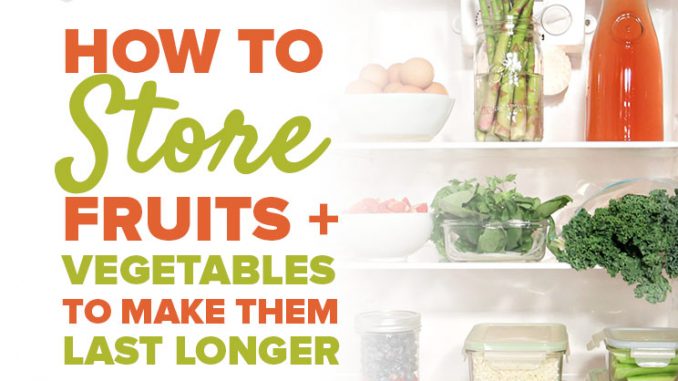
Keep your berries bright and celery crisp with this easy guide to common produce!
Get the most out of your favorite antioxidant-filled ingredients with these refrigerator storage tips!
If you look around your local supermarket, the layout is a great guide to how you should store your fresh produce once you get it home. To best preserve your healthy ingredients for optimal nutrition, we’ve broken it down so you can get the most bang for your buck and stop throwing away spoiled produce.
Do you struggle with bloating, gas, constipation, or other digestive issues? We’ve created a FREE guide to healing your gut naturally.
Click here to get your FREE copy of our Digestion Guide!
Fruits + Veggies Not to Be Refrigerated
- Hard squash like spaghetti, butternut and acorn do not require refrigeration due to their tough exterior.
- Tomatoes are another veggie that is best and most flavorful when kept at room temperature.
- Bananas especially like to be at room temperature, and this tropical fruit will quickly turn brown in cooler temperatures.
Prepped + Chopped Veggies
Store chopped veggies in an airtight container to help them hold their moisture and crispness. Veggies like broccoli and cauliflower don’t need extra moisture. Cauliflower that has been “riced” will keep best stored in an airtight container without any added liquid.
Asparagus, Celery + Carrots
These veggies crave moisture. Store them with a little bit of water in a glass container. If they should start to wilt or soften from being stored without moisture, they might just be dehydrated and need water. Slice off the bottom and stand them in a wide mouth mason jar with a little bit of water in the refrigerator. This will help them absorb the water and get back to their crunchy selves.
Berries
Berries are often the first fruit to show signs of spoiling, which is a waste of the precious fruit and your money. To avoid mold from growing, rinse berries in a water bath with a splash of vinegar for a few minutes. Then pat them dry and store in an airtight container. Vinegar prevents mold spores from growing and increases the shelf life of fragile berries. Strawberries like to stay dry, so be sure to pat them extra dry.
Leafy Greens
Leafy greens, much like soft herbs, like to have a bit of moisture and a cool temperature. Store them with a damp paper towel in a large recyclable plastic bag to help them maintain their deep green color. Yellow leaves, especially on kale, are a sign that the greens are starting to expire.
Herbs
Fresh herbs that are on the dryer side, like rosemary and thyme, should be kept dry and stored in a recyclable plastic bag. Softer, moister herbs like cilantro and basil like to have a little bit of moisture. A damp paper towel stored with them in a container or baggy will add moisture without making the herbs mushy. Try not to overcrowd herbs in a baggy; when one starts to get brown, the whole bunch can quickly spoil. If they are fanned out or loosely packed, they have room for air and moisture to circulate.
Fresh Juice / Nut Milks
Store freshly squeezed juice in a clear glass pitcher. Fresh juice can get murky and spoil, so a glass container allows you to monitor color and texture changes that can indicate spoilage. This is also true for homemade nut milks.
Apples and Citrus
Apples and citrus fruit are low maintenance and have a relatively long shelf life compared to berries. Store them in your refrigerator drawer, where it is dry and cool.
Nightshades
Nightshades like eggplant and bell peppers keep best in the refrigerator crisper to maintain their texture.
Via Paleohacks
